At the invitation of Firefly Mission and Buddhist Fellowship, Brother Hing Seng Huat of the Mandarin Dhamma Class and myself accompanied Bhante Raja as kappiyas for a short trip to Central Java on humanitarian mission from April 27th to May 1st 2013.
Incidentally, Sisters Suriaty ‘Sue’ Simon, Lily Chan and som e other MVBT members were also among the volunteers in the group.

Warm reception at the airport. The beaming smile on their face showed
enthusiasm in welcoming their guests.
Purpose of Mission
The main purpose of our trip was to learn and gain first-hand experience from the veterans how they organised and managed a large group of 40 volunteers (both the administrative and logistic aspects) in the execution of a successful mission distributing about 2,000 items to 430 students and 150 families at various schools and villages.
Logistical Tasks
Dana items were packed in bulk for ease of transportation by air and upon arrival, they were re-packed into individual packages and sorted out for distribution to the various villagers and students destined for the orphanage with 80 students; secondary schools with 80 students; high school with 200 students and Buddhist village with 70 students and 150 families.
The wish list of the beneficiaries include old clothes, candies, soft cakes, biscuits, instant noodles and stationery items consisting of 430 pieces each of blue and black pens, rulers and 80 boxes of colouring pencils.
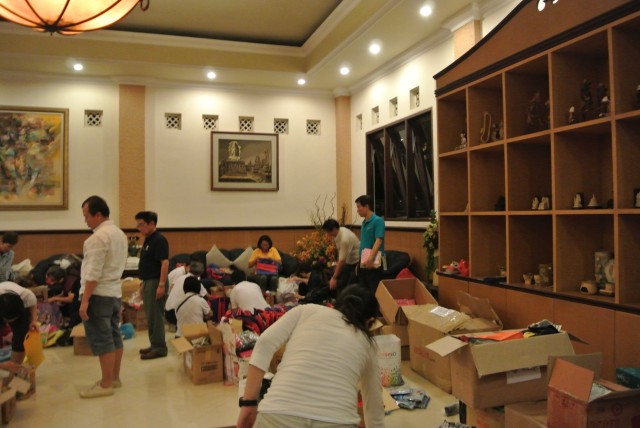
Sorting out the wish list items comprised of more than 2,000 articles.
Workforce Planning
It was a mammoth task to repack more than 2,000 items to accommodate a variety of specific needs. Volunteers were divided into workstations and assigned to a school or village. Each workstation was manned by a group of volunteers and with division of labour, formed an assembly chain, each taking care of an item to be placed it into a bag as it travelled down the line until all the necessary items were completely put into the bag.
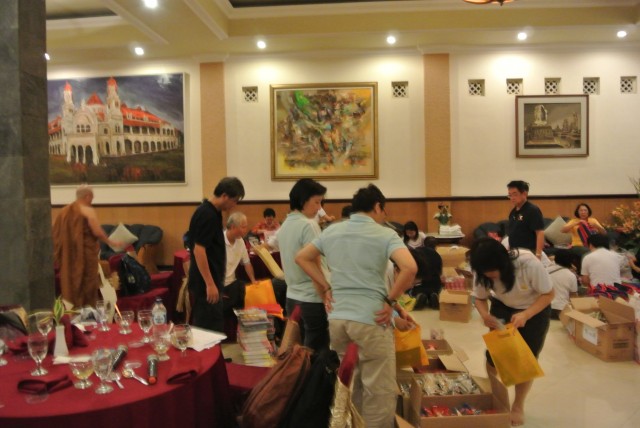
Breaking up of bulk ‘cargo’ and repacked into individual packages
with volunteers divided into workstations with each station formedan assembly chain to put the items into the bag.
With experience and good organisational skill, what seemed to a mammoth task was completed smoothly with little or no hiccups.
Visit and Distribution of Dana to recipients
We visited the Jhinndharma Sardha Temple to distribute food items and gifts to the teachers and students and were welcomed with a traditional dance performance by the students.
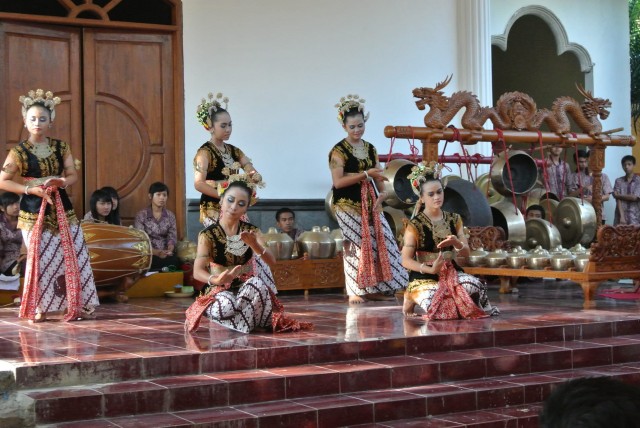
Welcoming traditional dance by the students for the visitors.
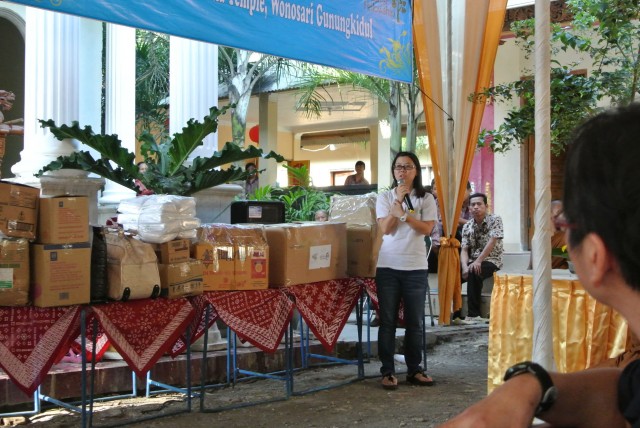
Emcee Sister Sue with gifts for the teachers and students announcedthe pleasant news before presentation.
At SMP Smartatungga Ampel
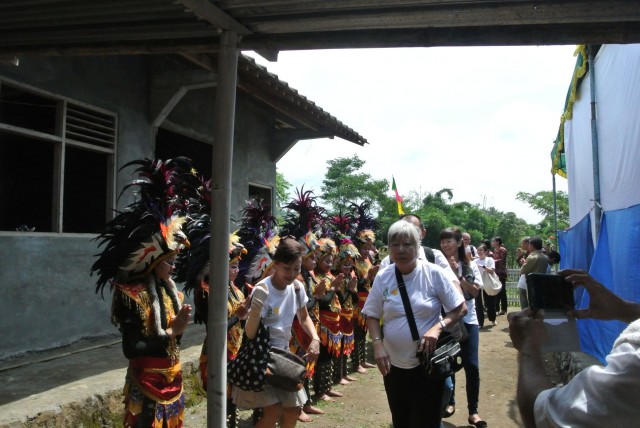
Welcoming party lined the road to greet the visitors.

Volunteers unpacked goodies for distribution to the students.
At Secondary and High School and STIAB College.
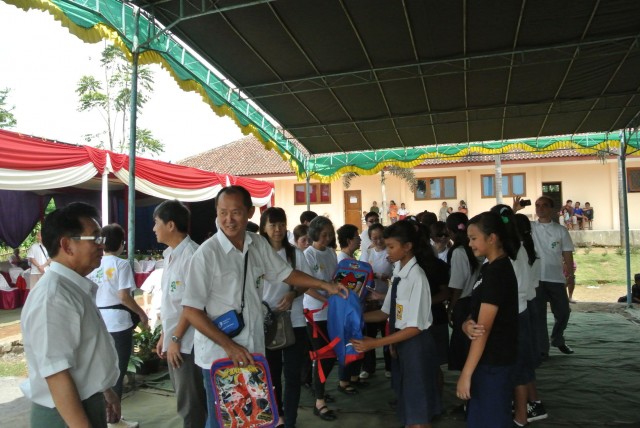
Distribution of gifts to the deserving students…
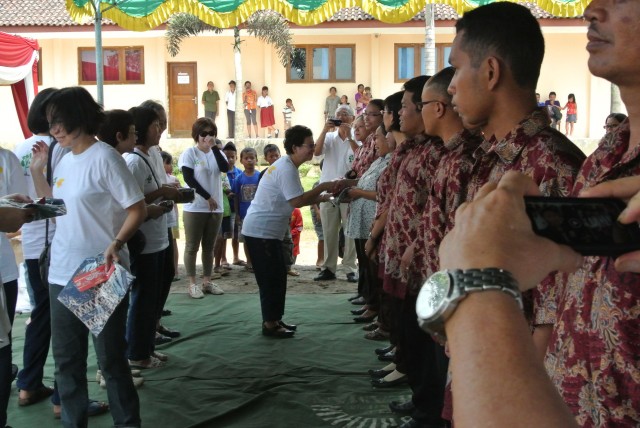
………. and deserving teachers and ancillary staff.
At Vihara Wening Sari, Banaran
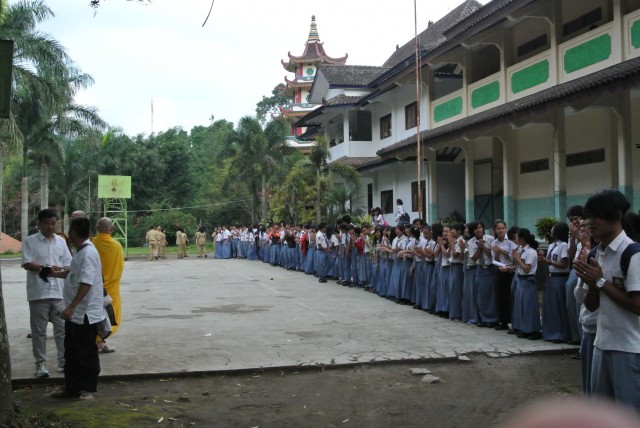
Eager students in anjali gesture lined up to greet the visitors in anticipation of our arrival.
At Kopeng Buddhist Village
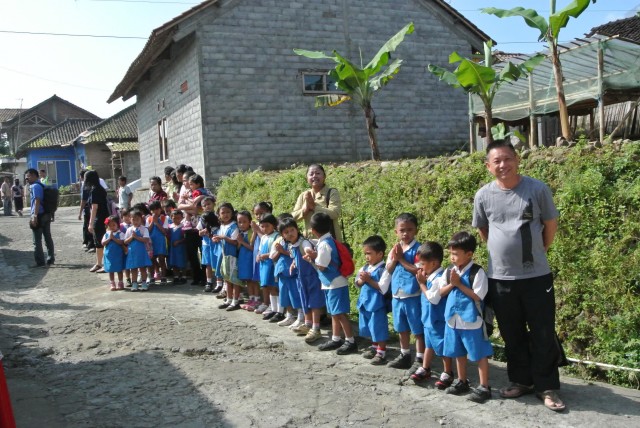
Kindergarten students in anjali gesture lined the street to greet the visitors.
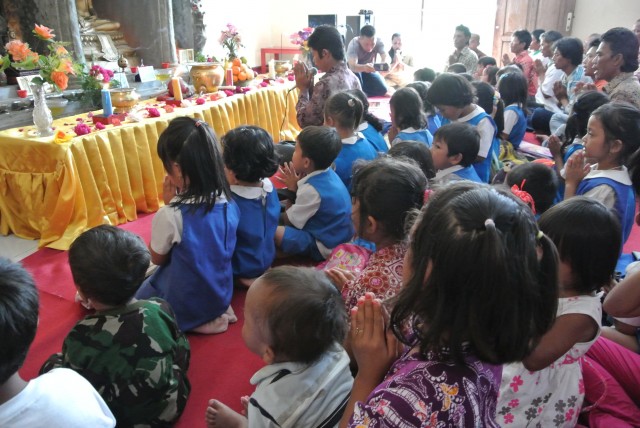
Morning puja attended by devotees of all ages ranging from infants to elderly adults.
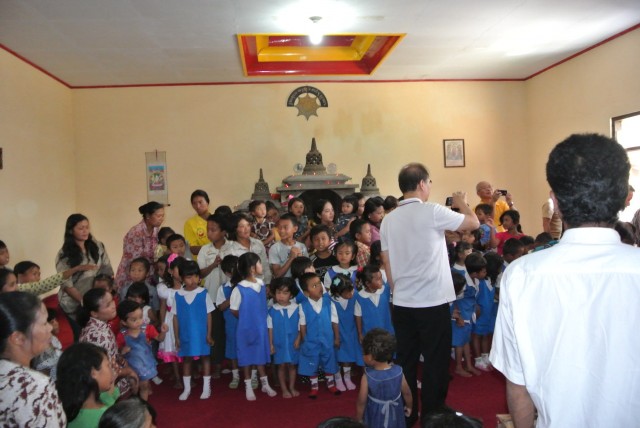
Students lined up, waited eagerly to receive their gifts.
Getaway to Rato Boka and Borobudur
Along the way to the village or schools we made short detours to visit Ratu Boka and Borobudur Temple.
Rato Boka, an archaeological site of a royal palace of Old Mataram Kingdom is located on a plateau, about 3 kilometers south of Parambana Temple at an altitude of 195.97 meters above sea level with an area of about of 160,896 square meters.
Ratu Boka palace was used by the Sailendra Dynasty long before the time of King Samaratungga who established the Borobudur Temple.
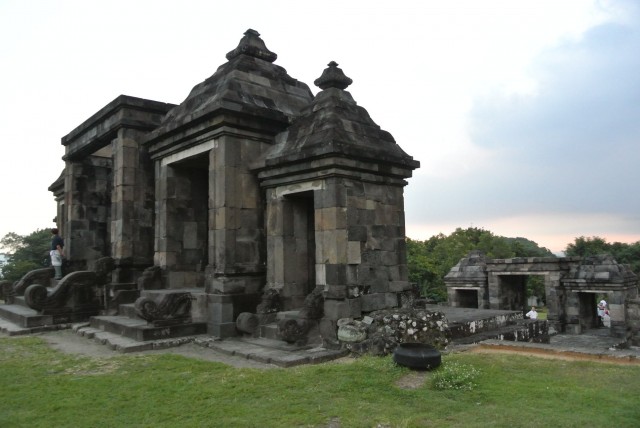
Gateway to the ruins of the royal Rato Boko palace of the Old Mataram Kingdom.

Take five to rest their tired feet on the steps of the gateway.
Borobudur’s name originated from words Boro and Budur, where Boro means temple or shrine from the Sanskrit word ‘Byara’ while Budur derives from Balinese word “Beduhur” which means above the hills.
Borobudur Temple, inherited by Buddhists is an ancient temple built as a place for meditation or to stand in silence, is located in the sub district of Borobudur, Mageland Regency, Central Java Province, about 269 meters above sea level and surrounded by several mountains. It is built as stepped pyramid was made of piles of more than 2,000,000 andesitic rocks.
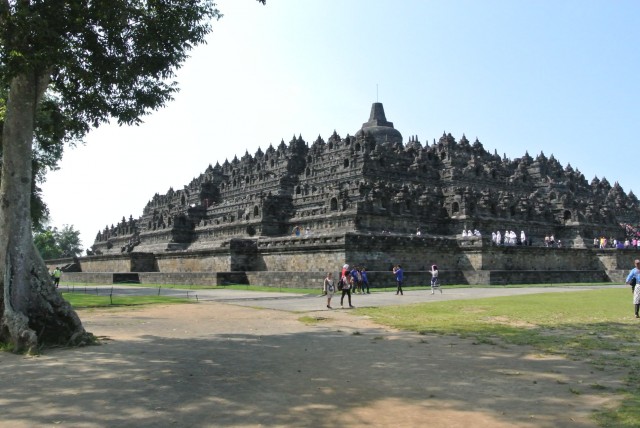
Borobudur Temple built as a stepped pyramid made up of more
than 2 million andesitic rocks with the Stupa at the pinnacle.
Stupa in Borobudur Temple is constructed in accordance with Buddhist concept and which is a replica of the universe. There are 504 statues of Buddha in the holed stupas (domes) on the three terraces under the main stupa with 72 statues were known as “Wajra Satwa”.
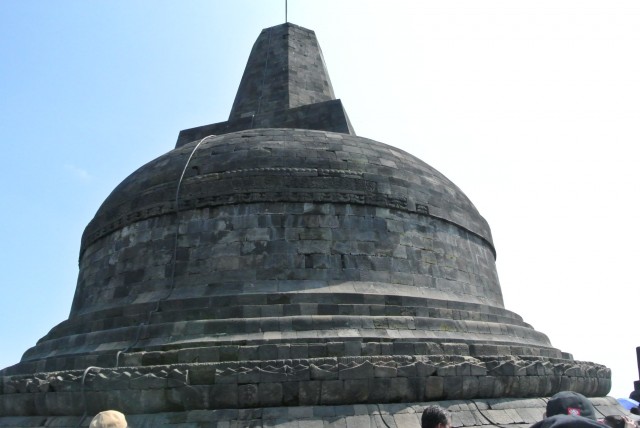
Close-up view of Stupa in Borobudur Temple in accordance with
Buddhist concept is a replica of the universe.
Where I stood on the steps of the terrace of Borobudur Temple, I recalled the lesson on the spread of Buddhism to Indonesia, taught in the English Dhamma Class. To learn more on English Dhamma Class please refer to the link http://edhamma.net/?p=2089 “Buddhism in Daily Life – A New Course”.
Lord Buddha after attainment of Enlightenment and having observed the first vassa-residence at Isipatana, Migadăya, sent forth the sixty disciples to go on missionary work:
“Bhikkhus, go out in all the eight directions for the mundane and supramundane welfare, prosperity and happiness of the many beings , such devas, humans and Brahmas. Let not two of you travel together for each journey, ………………………..
“Bhikkhus, teach the Dhamma that is full of virtuous qualities in all its three phases, namely, the beginning, the middle and the end; and endowed with the spirit and the letter. ……………………..
“Bhikkhus, there are many beings, such as devas, humans and Brahmas, who have little dust of impurity in their eyes of wisdom. Through not hearing the Dhamma, they will suffer a great loss of the extraordinary Dhamma which is the Path and the Fruition.” (Maha Vegga, 19 – 20).
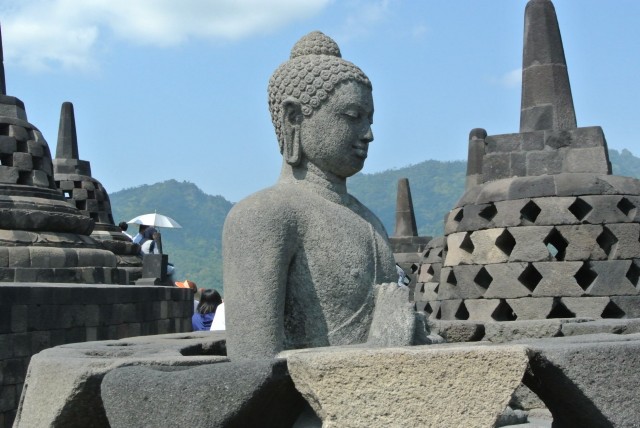
Statues of Buddha in the holed stupas (domes) on the three terraces under the main stupa with 72 statues were known as “Wajra Satwa”.
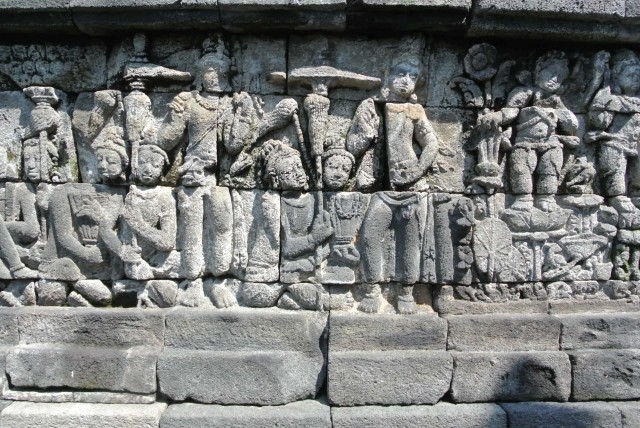
One of the 1,460 reliefs on Borobudur Temple wall depicts scene
from the story in the book of “Maha Karma Wbangga”.
The majestic monument is a living proof of Buddhism at the apex of its glory in Indonesia. The missions of successive disciples, over long period of time spread Buddhism beyond the borders of India and throughout most of the ASEAN countries and other parts of the world.
Homeward Bound
On our way to Jakarta Airport for our return journey to Singapore, we stopped by Parasadha Jinarakkhita for lunch.
Invaluable lessons and experience gained from this trip would help us to plan future trips on our own when the occasion arises.
Sadhu! Sadhu! Sadhu!
Contributor: Chin Kee Thou
English Dhamma Cllass
8th May 2013



